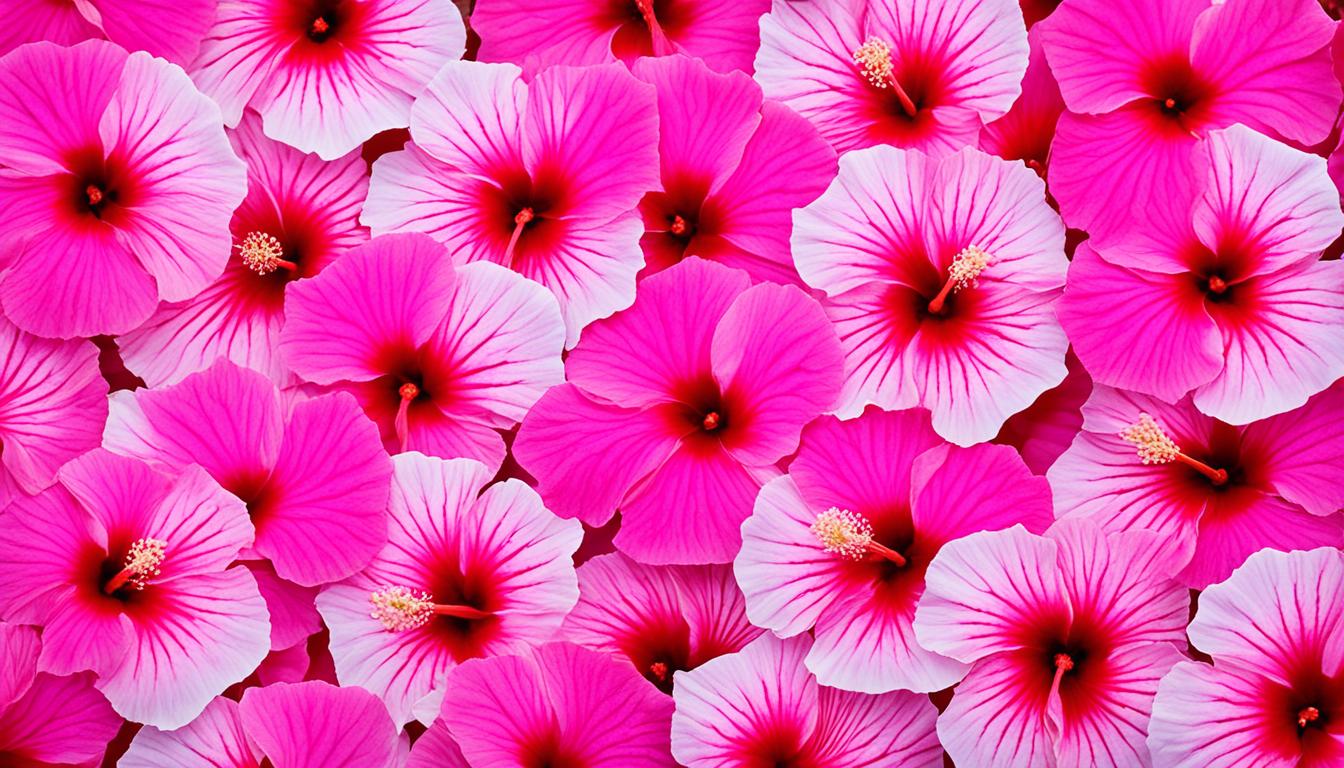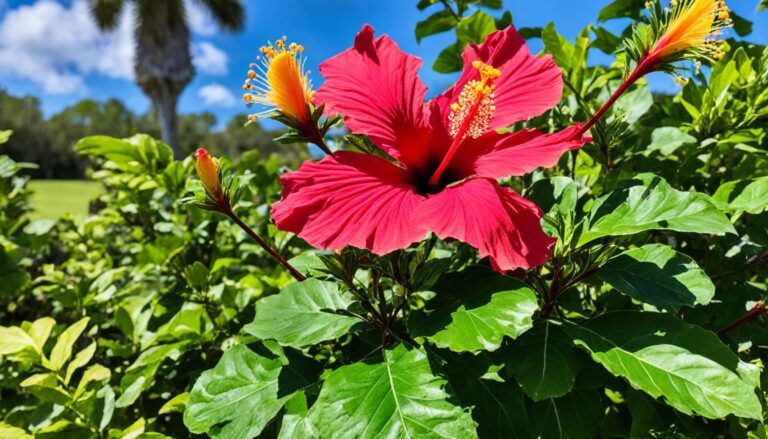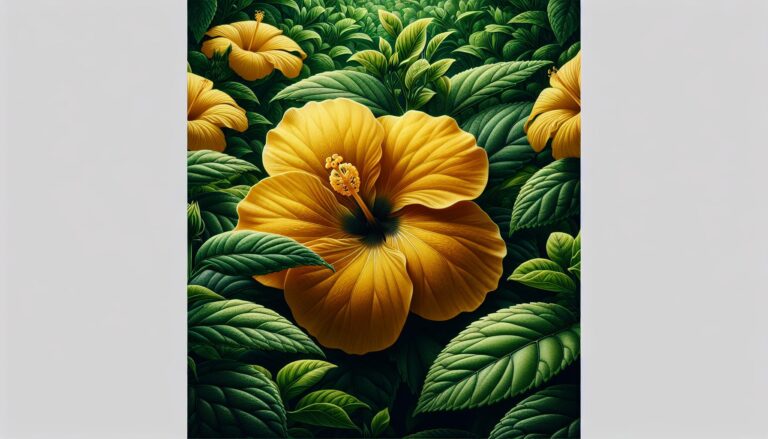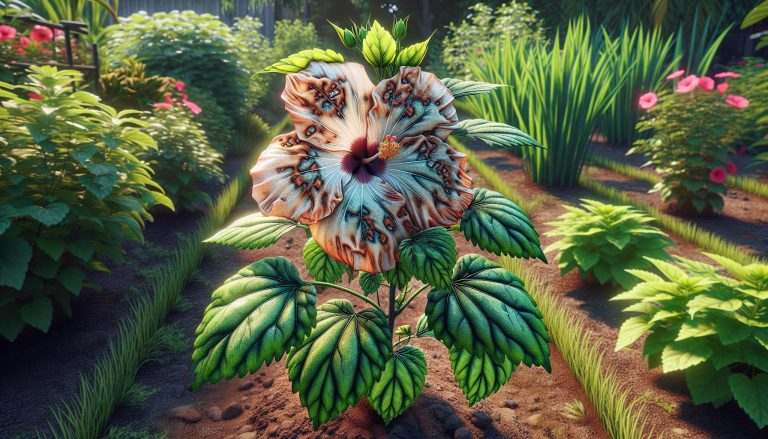Edible Hibiscus Flowers: Uses & Benefits Guide
Have you ever taken a bite of a flower? It may sound unusual, but the world of edible flowers is a hidden treasure trove of flavors and beauty. One particular flower that has been captivating chefs and food enthusiasts alike is the hibiscus flower. Its vibrant petals in hues of crimson and pink are not just an aesthetic delight but also a culinary delight.
Imagine the tantalizing aroma of a freshly brewed cup of hibiscus tea, its rich ruby color reflecting in the sunlight. Or the delicate balance of flavors in a hibiscus-infused dish, adding a touch of tanginess and floral notes. The edible hibiscus flower, also known as Hibiscus sabdariffa, is a culinary delight waiting to be explored.
Key Takeaways:
- Edible hibiscus flowers, such as Hibiscus sabdariffa, offer a range of culinary possibilities.
- Hibiscus can be used to make teas, infusions, and flavorful dishes with its unique tangy and floral notes.
- The vibrant colors and nutritional benefits of hibiscus make it a versatile ingredient that can elevate any recipe.
- Regular consumption of hibiscus tea has been linked to potential health benefits, including blood pressure regulation and antioxidant properties.
- Explore the world of edible flowers and unleash your culinary creativity with the enchanting hibiscus flower.
Hibiscus Sabdariffa: The Most Widely Used Edible Hibiscus Flower
Hibiscus sabdariffa, also known as Roselle, Red Sorrel, Cranberry Hibiscus, or Florida Cranberry, is the most commonly cultivated edible hibiscus flower. With its vibrant red calyxes and yellow flowers, this tropical plant is a staple in cuisines and beverages around the world.
The calyxes of Hibiscus sabdariffa are the main attraction. They are used to make delectable jellies, jams, and refreshing beverages. If you enjoy the tart and fruity taste of cranberries, you’ll love the flavor of these calyxes. They add a unique twist to your culinary creations.
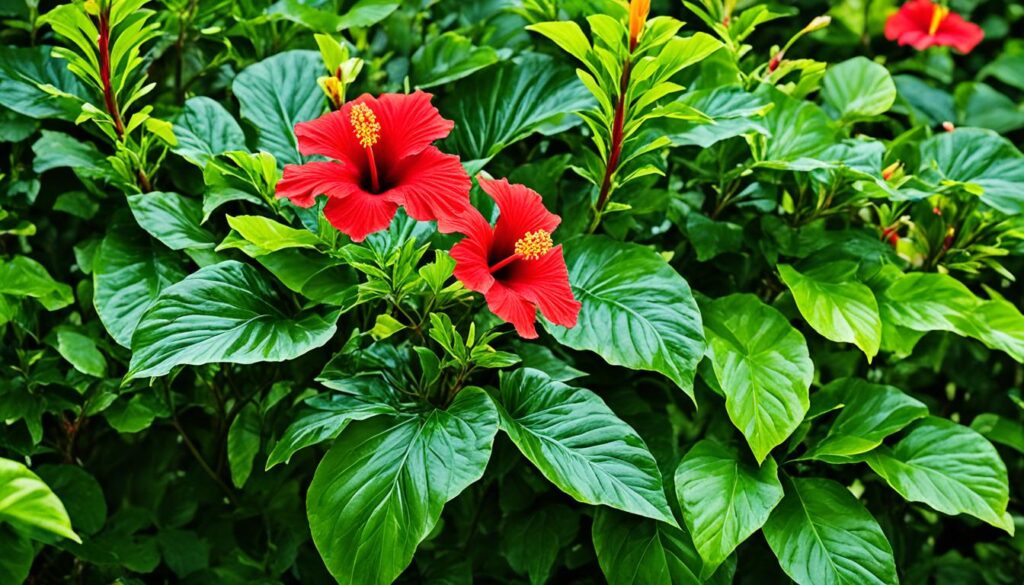
The flowers of Hibiscus sabdariffa are small and short-lived, usually lasting only a day before withering away. They range in color from pale yellow to pinkish white and make a beautiful addition to salads or garnishes for your dishes.
As the calyxes mature, their color deepens, and they become richer in anthocyanin pigments, giving them their vibrant red hues. These pigments not only add visual appeal but also offer potential health benefits.
Accessible in dried form, Hibiscus sabdariffa calyxes are convenient for various culinary preparations. From infusions and teas to baking and cooking, you can explore endless possibilities with this versatile ingredient.
Can All Hibiscus Flowers Be Eaten?
The beauty of hibiscus flowers extends beyond their vibrant hues and alluring blooms. While all hibiscus flowers are edible, the Hibiscus sabdariffa variety stands out for its exceptional nutritional and medicinal properties.
The star of the show is the calyx, the protective fruit that cradles the hibiscus seed. This calyx is commonly used to make the beloved hibiscus tea, a refreshing beverage enjoyed hot or cold. Not only does hibiscus tea offer a delightful taste, but it is also packed with essential nutrients such as Vitamin C, Magnesium, and Calcium.
Hibiscus flowers, leaves, seeds, and roots have been valued ingredients in traditional cooking and medicine for centuries. The flowers can brighten up salads with their vibrant colors, while the leaves add a tangy flair to stews, soups, and curries. As for the seeds, they can be consumed as a coffee substitute, offering a unique and flavorful alternative.
- All hibiscus flowers are edible.
- Hibiscus sabdariffa is the variety known for its high nutritional and medicinal properties.
- The calyx, or fruit, is the key ingredient used to make hibiscus tea.
- Hibiscus tea is rich in nutrients like Vitamin C, Magnesium, and Calcium.
- Hibiscus flowers, leaves, seeds, and roots are used in traditional cooking and medicine.
- Flowers can be added to salads, leaves used in stews, soups, and curries, and seeds consumed as a coffee substitute.
So, the next time you feast your eyes on a hibiscus flower, remember that its allure goes far beyond visual beauty. Embrace the rich culinary and medicinal potential that lies within, and indulge in the wonderful world of edible hibiscus flowers.
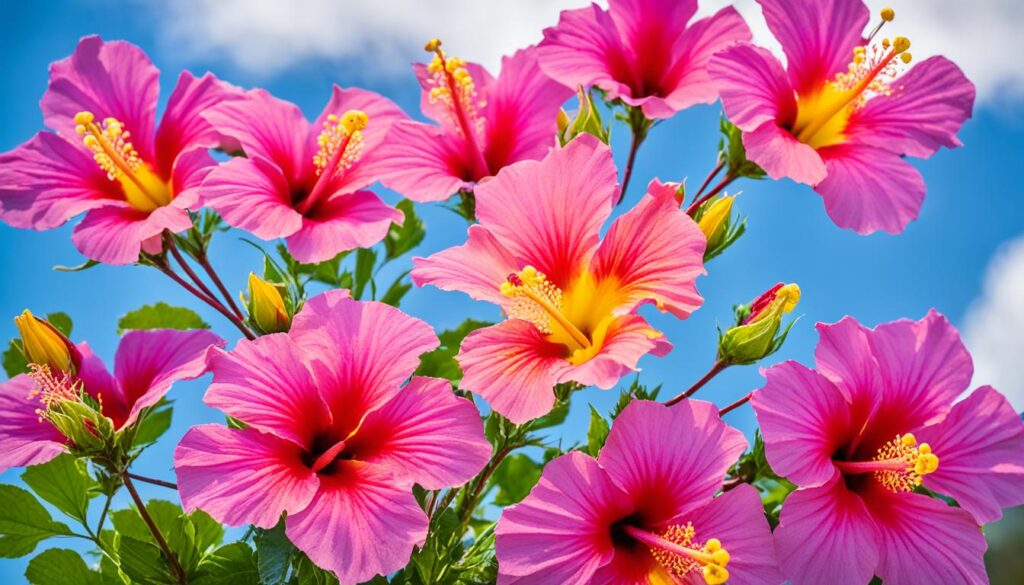
How To Use the Different Parts of the Hibiscus Sabdariffa
Hibiscus sabdariffa is a versatile plant that offers various edible components, including the flowers, leaves, seeds, and roots. Each part of the plant has its own unique flavors and culinary uses, allowing you to incorporate the vibrant and nutritious hibiscus into a variety of dishes.
Using the Hibiscus Calyx
The calyx, also known as the fruit, is the most commonly used part of the hibiscus plant. It is rich in flavor and can be utilized in several culinary creations.
One popular way to use the hibiscus calyx is by making jams, jellies, and syrups. The tart and tangy flavor of the calyx adds a unique twist to sweet spreads and toppings.
Another popular method is brewing hibiscus tea. Infusing the calyx in hot water creates a delightful beverage with a refreshing taste and vibrant crimson color.
Utilizing the Hibiscus Flowers
Hibiscus flowers are not only beautiful but also provide a nutritional boost to your meals. The flowers can be used in salads to add a touch of color and a mild floral essence.
Additionally, the flowers can serve as a garnish, enhancing the visual appeal of your dishes. Their delicate petals can elevate everything from desserts to savory entrées.
Incorporating the Hibiscus Leaves
The hibiscus leaves have a slightly spicy and tangy flavor, making them a versatile ingredient in various culinary dishes. They are commonly used in stews, soups, and curries to enhance the overall taste and add a hint of freshness.
You can also consider using hibiscus leaves as a wrap for steamed or grilled foods, imparting a subtle herbal aroma to the dish.
Exploring the Hibiscus Seeds
The seeds of Hibiscus sabdariffa offer yet another delightful culinary possibility. They can be consumed as a substitute for coffee, providing a rich and nutty flavor profile.
Roasting and grinding the seeds allow you to create your own hibiscus seed coffee, a caffeine-free alternative with a unique twist.
Drying and Using the Different Parts
All the different parts of the hibiscus plant can be dried and stored for future use. Dried hibiscus flowers, calyxes, leaves, and seeds retain their flavors and can be added to various recipes, teas, or as decorative elements in potpourri.
By drying the different parts of the plant, you can have a constant supply of hibiscus all year round, even when it’s not in season.
| Hibiscus Part | Culinary Uses |
|---|---|
| Flowers | – Salads – Garnishes – Desserts and savory dishes |
| Leaves | – Stews, soups, and curries – Food wraps |
| Seeds | – Coffee substitute |
| Calyx | – Jams, jellies, and syrups – Hibiscus tea |
Experimenting with the various parts of the hibiscus plant allows you to unleash your culinary creativity and explore the unique flavors and benefits this versatile plant has to offer.
Nutritional and Health Benefits of Roselle
Roselle, also known as Hibiscus sabdariffa, is a versatile plant that offers a wide range of nutritional and health benefits. It is rich in essential vitamins and minerals, including Vitamin C, Calcium, and Iron, making it a valuable addition to a healthy diet.
The plant contains antioxidant compounds that have anti-inflammatory and antibacterial properties, promoting overall well-being and supporting the immune system. Regular consumption of roselle can help protect against digestive issues, such as constipation, and may even have a preventive effect against colorectal cancer.
Moreover, roselle has been found to have potential benefits for heart health. It has been shown to help lower blood pressure and cholesterol levels, reducing the risk of cardiovascular diseases. By supporting proper cardiovascular function, roselle can contribute to a healthy heart and overall cardiovascular system.
Additionally, roselle can be beneficial in treating respiratory conditions such as coughs and colds. Its soothing properties help relieve symptoms and support the body’s natural healing processes. Roselle tea, in particular, is a popular remedy for respiratory ailments.
Studies have also suggested that roselle extract may possess anticancer properties, though further research is needed to fully understand its potential in cancer prevention and treatment.
To summarize, roselle, or Hibiscus sabdariffa, is a nutritional powerhouse that offers a range of health benefits. Its high content of vitamins and minerals, along with its antioxidative and anti-inflammatory properties, make it a valuable addition to a balanced diet. Whether consumed as tea or incorporated into various culinary preparations, roselle can help support overall health and well-being.
Nutritional Content of Roselle
| Nutrient | Amount per 100g |
|---|---|
| Vitamin C | 18.4mg |
| Calcium | 128mg |
| Iron | 8.58mg |
How to Grow Roselle from Seed
Roselle, or Hibiscus sabdariffa, is a beautiful and versatile plant that can be grown from seeds. Whether you have a garden or limited space for containers, you can enjoy the satisfaction of cultivating this annual plant. Here’s a step-by-step guide to help you successfully grow roselle:
- Choose the Right Spot: Select a sunny location for your roselle plants. Ensure that the soil is well-draining and rich in organic matter, such as compost.
- Prep the Seeds: To promote successful germination, soak the hibiscus sabdariffa seeds in water for about 24 hours. This process helps soften their hard skin and enhances their viability.
- Planting: Plant the seeds about 1cm deep in the soil and cover lightly with soil. Space the seeds according to the recommended planting distance, allowing enough room for the plants to grow and spread.
- Provide Optimal Conditions: Keep the seeds warm, moist, and exposed to plenty of sunshine. Roselle thrives in warm and wet weather conditions. Water the plants regularly, ensuring that the soil remains adequately hydrated.
- Monitor Growth: As the plants grow, they will start to develop vibrant and attractive flowers. With proper care and attention, roselle plants usually produce flowers and fruits within a few months.
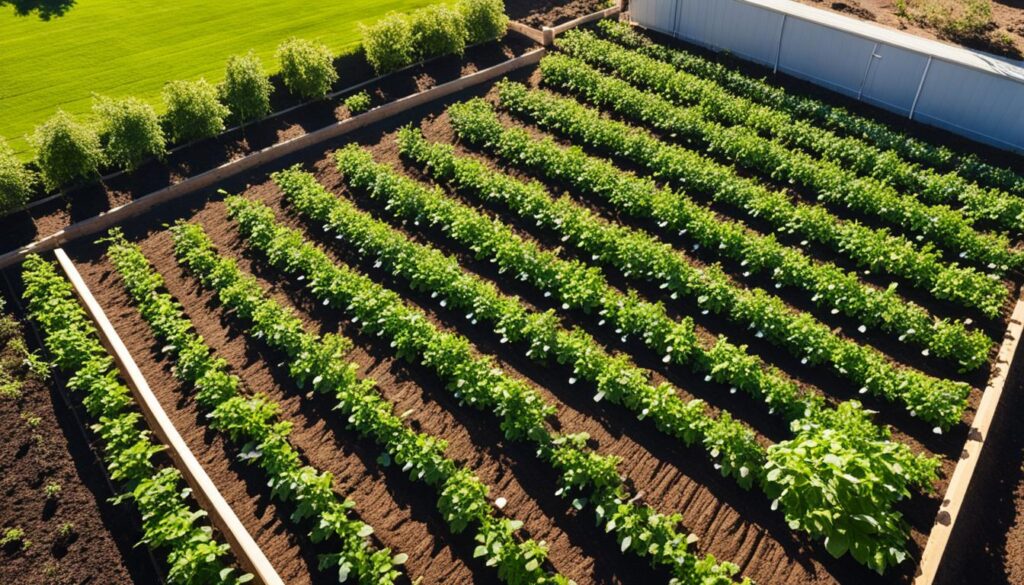
By following these simple steps, you can successfully grow roselle from seed and enjoy the beauty and benefits of this versatile plant in your own garden or containers. Remember to maintain the optimal growing conditions and stay patient as you witness the growth and development of your roselle plants.
How to Harvest Hibiscus Sabdariffa
Hibiscus sabdariffa flowers are typically in bloom towards the end of summer. After the flower petals fall off, the calyxes start to become fleshy and deep red within 3-7 days. When the calyxes are fully ripe, they can be harvested for use.
The ripe calyxes are plump and can be gently snipped from the plant. Inside the calyxes, there is a round seed pod, which can be kept for future planting. The harvested calyxes can be used immediately or dried for later use.
To ensure the best flavor and quality, it is recommended to harvest the calyxes when they are fully ripe. Ripe calyxes will have a vibrant red color and a slightly tart taste.
Harvesting Hibiscus Sabdariffa Calyxes
Here’s a step-by-step guide on how to harvest hibiscus sabdariffa calyxes:
- Wait for the flower petals to fall off and the calyxes to turn deep red.
- Gently hold the stem of the calyx and use scissors or pruners to snip it from the plant.
- Inspect the harvested calyxes for any signs of insect damage or disease. Discard any damaged calyxes.
- If not using immediately, store the calyxes in a cool, dry place to preserve their quality.
Harvesting hibiscus sabdariffa calyxes is a rewarding process that allows you to enjoy the rich flavors and vibrant colors of this versatile plant. The harvested calyxes can be used in various culinary creations, including teas, jams, jellies, and sauces.
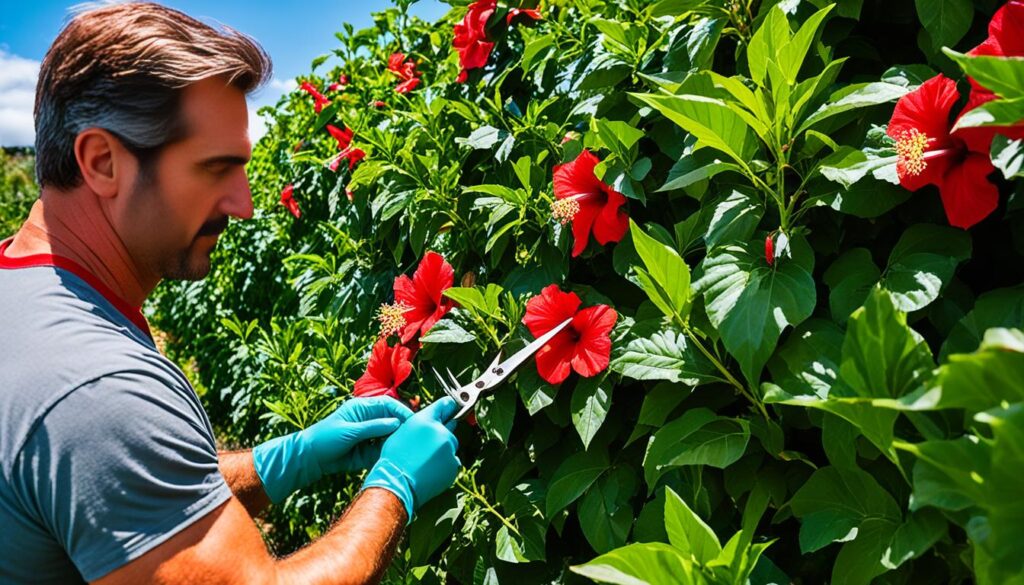
Benefits and Uses of Hibiscus
Hibiscus is a versatile plant with numerous benefits and uses. Whether consumed as a tea or incorporated into culinary creations, hibiscus offers a range of advantages for overall well-being and flavor enhancement.
Health Benefits of Hibiscus
Hibiscus preparations, such as teas, powders, and extracts, provide several health benefits. Studies have shown that hibiscus can help lower blood pressure and manage metabolic syndrome. It may also have hepatoprotective properties, supporting liver health, and contain compounds with potential anticancer effects.
Hibiscus tea, which is enjoyed hot or cold, is a popular beverage known for its refreshing taste and potential health benefits. It is rich in antioxidants, vitamins, and minerals, making it a nutritious addition to any diet.
Uses of Hibiscus in Culinary Preparations
Hibiscus can be used in various culinary applications, adding vibrant colors and unique flavors to dishes. The tangy and slightly floral taste of hibiscus makes it a versatile ingredient in jams, jellies, and sauces.
Additionally, hibiscus can be used as a natural food colorant, adding a visually appealing touch to desserts, beverages, and confectioneries. Its vibrant red hue can elevate the aesthetic appeal of any dish.
More Research Needed
While hibiscus has shown promising health benefits and culinary uses, further research is necessary to fully understand the extent of its advantages and potential side effects. It is always recommended to consult with a healthcare professional or nutritionist before incorporating hibiscus into your regular diet or supplement routine.

Summary in Table Format:
| Benefits | Uses |
|---|---|
| Hibiscus can help lower blood pressure and manage metabolic syndrome. | Hibiscus tea |
| Hibiscus may protect the liver and have potential anticancer properties. | Jams, jellies, and sauces |
| Natural food colorant |
Dosage and Side Effects of Hibiscus
While hibiscus offers numerous health benefits, it’s important to be aware of its proper dosage and potential side effects.
Hibiscus dosage:
There are no standardized dosages for hibiscus preparations. However, drinking hibiscus tea in moderate amounts is generally considered safe. It’s recommended to consume hibiscus tea in moderation and follow the instructions provided on the packaging.
Potential side effects:
Prolonged use of high doses of hibiscus extract may cause liver injury. It’s important to avoid exceeding the recommended dosage and consult a healthcare professional if you have any concerns.
Hibiscus could potentially interact with certain medications. If you are taking any medications, especially blood pressure or diabetes medications, it’s advisable to consult a healthcare professional before incorporating hibiscus into your routine.
Pregnant or breastfeeding women should avoid hibiscus tea and supplements, as their safety during pregnancy and lactation has not been established.
It’s always a good idea to seek professional medical advice before starting any new supplement or herbal remedy, especially if you have any underlying health conditions or are taking prescription medications.
Remember, moderation is key when it comes to enjoying the benefits of hibiscus. By following the recommended dosages and consulting with a healthcare professional, you can safely incorporate hibiscus into your wellness routine.
Conclusion
In conclusion, edible hibiscus flowers, particularly Hibiscus sabdariffa, have a multitude of benefits and diverse uses. Whether incorporated into culinary creations, brewed as teas, or used as natural food colorants, these flowers offer a versatile addition to your meals and beverages.
Hibiscus flowers, leaves, seeds, and roots are all edible and provide different nutritional profiles. They have been associated with potential benefits such as lowering blood pressure, aiding in weight management, and supporting liver health. Additionally, hibiscus may possess anticancer properties and promote a healthy immune system.
However, it’s important to note that more research is needed to fully comprehend the extent of hibiscus’ benefits and potential side effects. As with any dietary adjustment or herbal supplement, it is advisable to consult a healthcare professional before incorporating hibiscus into your routine. They can provide personalized guidance and ensure its compatibility with your specific circumstances.

